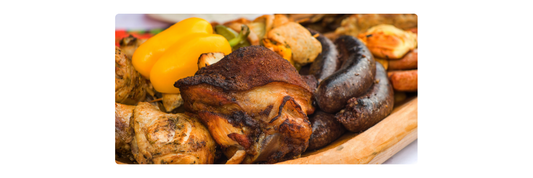Do you ever find yourself savoring your morning cup of coffee or enjoying a glass of wine with dinner, only to be greeted by that uncomfortable burning sensation in your chest? You're not alone. Many people experience heartburn and acid reflux after consuming acidic beverages like coffee and wine. In this blog, we'll delve into the connection between acidity in these beloved drinks and digestive discomfort, all while keeping things light and informative.
Understanding Heartburn and Acid Reflux

Heartburn and acid reflux are like unwelcome guests at the dinner table – they show up uninvited and can ruin a perfectly good meal. Simply put, heartburn occurs when stomach acid flows back up into the esophagus, causing a burning sensation in the chest or throat. Symptoms may include a sour taste in the mouth, chest pain, or difficulty swallowing.
The pH Scale and Acidity

To understand why certain beverages trigger heartburn, we need to talk about the pH scale. Imagine a scale from 0 to 14, with 0 being the most acidic, 7 being neutral, and 14 being the most alkaline. Acids have a pH lower than 7, while alkaline substances have a pH higher than 7. For example, lemon juice has a pH of around 2, making it highly acidic, while water has a neutral pH of 7.
To truly grasp the impact of acidity on our bodies, let's delve deeper into the fascinating world of the pH scale. Picture a numerical scale ranging from 0 to 14, with 7 as the midpoint. Each point on this scale represents a tenfold difference in acidity or alkalinity. This means that a substance with a pH of 4 is ten times more acidic than one with a pH of 5, and a whopping hundred times more acidic than one with a pH of 6.
The exponential nature of the pH scale can be mind-boggling, but it's essential for understanding the potency of acids and bases. For instance, lemon juice, with its pH of around 2, is not just slightly more acidic than water (pH 7) – it's actually 100,000 times more acidic! This exponential relationship underscores why even small changes in pH can have significant effects on our bodies.
Now, let's apply this knowledge to our discussion of acidic beverages like coffee and wine. While coffee typically falls within the pH range of 4 to 5, and wine around 3 to 4, these seemingly minor differences in pH can translate to vastly different levels of acidity. For example, a coffee with a pH of 4 is ten times more acidic than one with a pH of 5, and a hundred times more acidic than water. Similarly, a wine with a pH of 3 is ten times more acidic than a coffee with a pH of 4.
Understanding the exponential nature of the pH scale allows us to appreciate the nuanced differences in acidity among various beverages. It also highlights why certain acidic drinks may trigger heartburn and acid reflux in susceptible individuals. When acidic substances come into contact with the delicate lining of the esophagus, they can cause irritation and inflammation, leading to the characteristic discomfort of heartburn.
In addition to acidity, the volume and frequency of acidic beverage consumption can also impact digestive health. Even beverages with relatively low pH levels can cause issues if consumed in large quantities or on an empty stomach. Therefore, it's essential to be mindful of both the acidity of our drinks and our drinking habits to maintain optimal digestive function.
By understanding the exponential nature of the pH scale and its implications for acidity, we gain valuable insights into how certain beverages can affect our bodies. Armed with this knowledge, we can make informed choices about what and how much we consume, promoting digestive comfort and overall well-being.
Acidic Beverages: Coffee and Wine

Now, let's turn our attention to two of life's simple pleasures: coffee and wine. Both beverages contain natural acids that can irritate the stomach lining and trigger heartburn. Coffee, especially when brewed strong, can have a pH ranging from 4 to 5, making it moderately acidic. Similarly, wine, particularly red wine, contains tartaric and malic acids, which can also contribute to acidity levels ranging from 3 to 4.
Managing Acidic Beverages and Heartburn

If you're a coffee enthusiast or a wine connoisseur, fear not! There are ways to enjoy these beverages without aggravating heartburn symptoms. Opt for low-acid coffee blends or cold brew, which tend to be gentler on the stomach. When it comes to wine, consider choosing white varieties over red, as they generally have lower acidity levels. Additionally, diluting wine with water or pairing it with food can help mitigate its effects on digestion.
Conclusion and Final Thoughts
While coffee and wine can be delightful indulgences, their acidity may lead to heartburn and acid reflux for some individuals. By understanding the pH scale and making mindful choices about beverage consumption, you can help alleviate digestive discomfort and enjoy your favorites in moderation. Remember, it's all about balance and listening to your body's cues. Cheers to good health and happy sipping!
Managing Acidic Beverages

If you're someone who loves their coffee or enjoys a glass of wine but experiences discomfort afterward, fear not! There are innovative products on the market designed to tame the acidity of these beloved beverages and make them gentler on the stomach.
Enter the realm of "coffee tamers" and "wine tamers" – specially formulated products aimed at reducing the acidity of coffee and wine without compromising on flavor. These ingenious solutions offer a convenient way to enjoy your favorite drinks without the digestive.
References:
American Gastroenterological Association. "Understanding Heartburn and Reflux Disease." gastro.org.
National Institute of Diabetes and Digestive and Kidney Diseases. "Heartburn, Gastroesophageal Reflux (GER), and Gastroesophageal Reflux Disease (GERD)." niddk.nih.gov.




